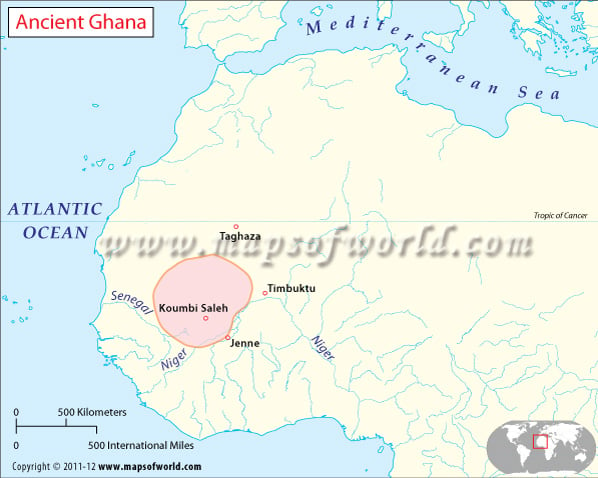The Empire of Ancient Ghana was located in southern Mauritania and northern Senegal. The empire seems to have its origins in the seventh century AD, and was known to the natives as Wagadou. The word Ghana itself represents the kings who ruled the land. The land was called Ghana by the Arab traders who mistook the name of the kings to be that of the country.
Ghana grew in financial and military prowess because of the booming trade that came along with the introduction of camels. The Empire of Ghana soon covered all the land between the Niger and Senegal Rivers.
The Legend of Ouagadou-Bida
Legends attribute the wealth and prosperity of Ancient Ghana to the propitiation of Ouagadou-Bida. Ouagadou-Bida, a black serpent, lived in a sacred orchard in Ghana and protected the kings of the land. The kings ruled wisely and the empire grew richer every passing year.
Ouagadou-Bida was propitiated by the sacrifice of a young virgin every year. One year, a girl named Sia was chosen for the sacrifice. Amadou Sefedokote (sometimes called Mamadou Sarolle), Sia’s fiance, was distraught and decided to save Sia. He beheaded the serpent seven times, as the snake’s head kept regrowing. At last Amadou Sefedokote succeeded in killing Ouagadou-Bida. Though Sia was saved, Ghana lost its benefactor spirit. A calamitous drought then befell the land. Crops and animals died, and gold mining started to decline. The Empire of Ghana lost its prosperity and the people became nomads.
Though mythical in its origins, the legend of Ouagadou-Bida seems to be based on facts. Archaeologists believe that Ghana was a rich and prosperous nation until the twelfth century, after which a famine struck the land, killing crops, sheep, goats, and cows.
Trade and Commerce
Ghana became renowned for its gold mines and for the wealth that the gold trade brought. Arab traders believed Ghana to be one of the richest gold reserves in the world. Ghana controlled the Trans-Sahara trade route, and the trade of ivory, silk, and spices made the empire influential. Slaves and salt were major imports, while textiles and jewelry were the major exports of Ghana.
Religion in Ancient Ghana
For a long time, the people of Ghana practiced a highly ritualistic pagan religion, in which they worshipped animal spirits and natural phenomena. But when trade routes opened, Islam made its presence felt in the Empire of Ghana. In Kumbi Saleh, the capital of the Ghana Empire, both the Islamic community and those who practiced the native religion coexisted peacefully for a long time, but eventually most of the natives converted to Islam.
Decline of the Empire
Prolonged drought and famine were undoubtedly significant contributors to the decline of Ghana. The kings of the land, having lost their trading monopoly, could not do much to recover the prosperity of their empire. With the opening of new gold fields in Guinea and Ghana’s dwindling reserves, trade was diverted farther east.
External invasions also played a significant role in the empire’s downfall. The Almoravid Muslims encroached upon the empire from the north. Sumanguru, the king of Sosso, launched repeated attacks, and the growing might of the Mali Empire (around 1240 AD) soon brought about the end of the Empire of Ancient Ghana.

 Ancient China
Ancient China